21 Search Results for multiple modalities
June 24, 2019
by Carole Zangari -
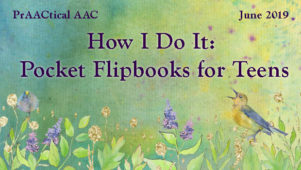
Thanks to all who reached out to express appreciation for Katherine Dally’s series on making and using flipbooks for adults and teenagers with complex communication. Today, she continues that series with a case example of how she used this to support a young woman who communicates through multiple modalities, including an SGD. Katherine is an SLP who works both as an AT consultant for an educational service center and as a home health SLP serving adults with neurological conditions in Ohio. We’re grateful to Katherine for sharing her experiences and for the downloadable materials that are linked at the end of her post If you missed her previous posts in this series, you may want to check those out: How I Do It – Pocket Flipbooks for Adults & Teens: Part 1, Part 2. :::::::::::::::::::::::::::::::::::::::::::::::::::::::::::::::::::::::::::::::::::::::::::::::::::::::::::::::::::: How I Do It: Pocket Flipbooks for Teens Let’s go through a teen case example... [Read More...]
November 8, 2018
by Carole Zangari -
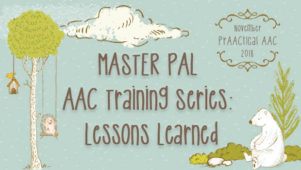
Thanks to all who reached out to express appreciation for Tabi Jones-Wohleber’s training resources in the MASTER PAL series. Many of you have already used the slides, video links, handouts, and discussion points that were shared over the past few months, and others have plans to do so. In this final post, Tabi shares some of the ‘lessons learned’ in creating and utilizing these materials. If you’re new to the series, you can check out each of the 11 modules here. ::::::::::::::::::::::::::::::::::::::::::::::::::::::::::::::::::::::::::::::::::::::::::::::::::::::::::::::::::::::::::::::::::; Over the last 11 weeks, facilitation strategies for communication partners have been shared through the Model as a MASTER PAL series. Model as a MASTER PAL is a framework for supporting communication partners of those who use AAC that evolved in response to the need go beyond the imperative and always present conversations of “use core words” and “model AAC”. It started as a list of ideas to... [Read More...]
October 11, 2018
by Carole Zangari -
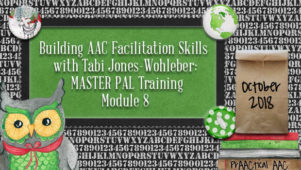
Our AAC Training Series continues today and we remain extremely appreciative that West Virginia based SLP Tabi Jones-Wohleber allows us to share these presentation materials. Today’s training materials center on a topic that will help AAC interventionists strengthen their relationships with AAC learners and provide important language learning opportunities at the same time. This module, Response NOT Required, is all about interactions that engage our learners and invite them into the conversation. The instructional time for Module 8 is about 20 minutes so this can feasibly be shared in a formal or informal sharing session before or after the school day. ::::::::::::::::::::::::::::::::::::::::::::::::::::::::::::::::::::::::::::::::::::::::::::::::::::::::::::: Model as a MASTER PAL Module 8: Response NOT Required Facilitator Guidelines When I talk about modeling without expectation of a response, I often get quizzical sideways glances. It is not an intuitive way of interacting, especially in an educational environment where responding is inherent in classroom... [Read More...]
September 20, 2018
by Carole Zangari -
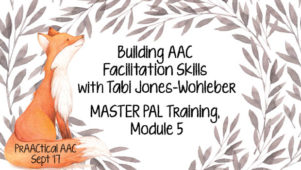
Our AAC Training Series continues today and we are incredibly grateful to Tabi Jones-Wohleber for sharing these presentation materials with us. Today’s training materials center on a topic that is near and dear to my prAACtical heart: Using statements more often than questions. The instructional time for Module 5 is about 90-120 minutes which allows time for discussion and practice. ::::::::::::::::::::::::::::::::::::::::::::::::::::::::::::::::::::::::::::::::::::::::::::::::::::::::::::: Model as a MASTER PAL Module 5: Statements More Than Questions Facilitator Guidelines STATEMENTS MORE THAN QUESTIONS Questions are necessary to help us learn about the things, people, and activities in our environment and beyond. However, interactions heavily weighted with questions do not often yield the quality exchanges required to build relationships, gain understanding, foster autonomous communication or facilitate initiation. This module explores the power of statements (aka nondirective language and descriptive teaching) in shaping meaningful engagement for learning and socially interacting. It includes interactive activities, video links, lots... [Read More...]
September 13, 2018
by Carole Zangari -
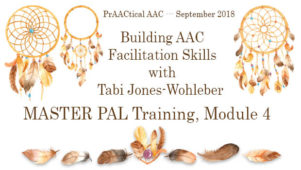
Ready for more AAC training materials? In today’s post, Tabi Jones-Wohleber is sharing another module in the MASTER PAL series. This 30-minute session focuses on the role of multiple modalities in AAC. :::::::::::::::::::::::::::::::::::::::::::::::::::::::::::::::::::::::::::::::::::::::::::::::::::: Model as a MASTER PAL Module 4: Accept Multiple Modalities Facilitator Guidelines We all use multiple modalities to communicate…speech, text, email, a gesture, facial expressions. In much the same way we encourage young children to interact by assigning meaning to their gestures, expressions, and utterances, responding meaningfully to the communicative attempts of those who use AAC validates and encourages the effort. Honor all modalities and respond by modeling AAC as much as possible(regardless of the modality used by the PWUAAC) teaches AAC. Seize the opportunity to teach and expand language. After all, multi-modal communication shapes the human experience. For this training you will need: The Presentation Slides The Presentation Handout The Facilitator’s Guide Warm-up Discussion: Thinking Prompt... [Read More...]
August 23, 2018
by Carole Zangari -
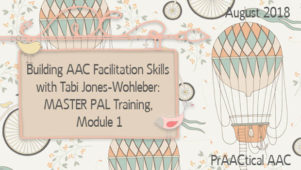
Are you… Hoping to train team members to be better communication partners for their AAC students/clients but overwhelmed by the thought of all the preparation? Relatively new to AAC and not sure what content to share in your training? Looking for additional resources to utilize in your existing training sessions? Good news, AAC friends! This post is for you. We’re so happy to have SLP Tabi Jones-Wohleber returning to the blog to share more of her wonderful AAC resources. Tabi works with young children at the West Virginia Birth to Three program and serves on the AT Team for Frederick County Public Schools in Maryland. Today, she launches a new series on partner training that focuses on the use of aided language input and other facilitative strategies. There are 11 modules in all (1 overview for administrative discussions and 10 for communication partners) and each one includes slides, handouts, discussion prompts, links... [Read More...]
April 14, 2012
by Carole Zangari -
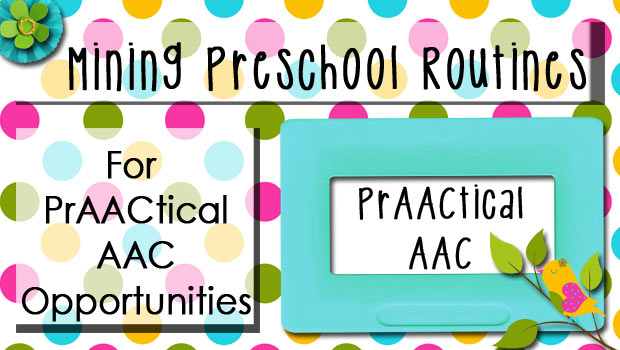
Meet Jenna, a spirited little girl with developmental delays who is learning to communicate using multiple modalities. Follow her along this morning as she goes to her preschool and gets dozens of opportunities to practice the AAC skills she is learning. 101 opportunities to practice target skills before lunch? It’s a piece of cake with this well-oiled preschool team! Jenna’s communicative functions are noted in CAPS and her communication modalities are in italics. – Let’s watch and see how Jenna is getting all that practice in as she goes about her day. – 7:55 1. Enter the building, pause at a trained adult communication partner (receptionist) for Jenna to GREET with a vocalization and wave 2. ANSWER a social question (“How are you?”) with gesture (thumbs up) 3. Say GOODBYE with a wave 4. Once in the classroom, repeat GREETINGS with teacher, aide, and a friend. 5. ASK for HELP putting... [Read More...]
February 4, 2012
by Carole Zangari -
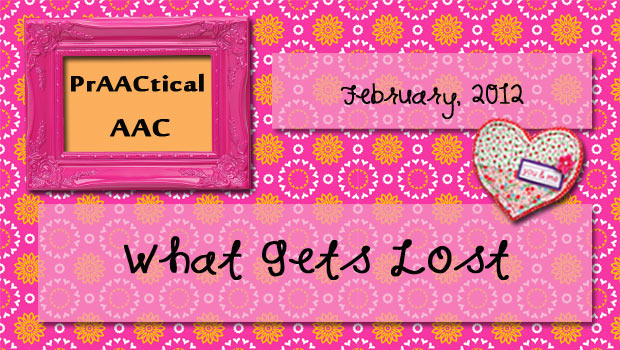
Imagine having one key communication strategy and no one knew that it existed. This horrifying experience was documented in the book ‘I Raise My Eyes to Say Yes,’ the autobiography of Ruth Sienkiewicz-Mercer. For years, she effectively used eye gaze with her family to answer yes/no questions, but when Ruth was placed at a residential facility, things eventually changed. Staff turnover, something we’re all familiar with, was the culprit. With time, new staff came in and didn’t realize that Ruth communicated with her eyes. Ruth was silenced for years until someone noticed that her ‘eyes up’ movement wasn’t reflexive or random. She was talking, but no one was listening. — While this was an extreme example, most AAC practitioners can recount their own stories of people whose AAC messages weren’t effectively translated once they moved to new settings. The transition to a new environment, where untrained partners may fail to recognize... [Read More...]
December 11, 2023
by Carole Zangari -
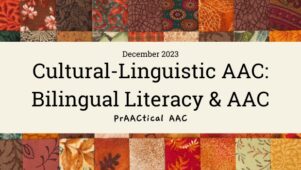
Our yearlong series on multilingual AAC support, guest-authored by BilingüeAAC, is drawing to a close. In today’s post, Melissa Tapia and Sarah Lee address AAC, bilingualism, and literacy. BilingüeAAC is a group of SLPs with a shared belief in providing evidence-based intervention strategies and resources to bilingual Spanish AAC clients, families, caregivers, and professionals. ::::::::::::::::::::::::::::::::::::::::::::::::::::::::::::::::::::::::::::::::::::::::::::::::::::::: Bilingual Literacy & AAC Welcome back to our Bilingue AAC Series! You can find our previous posts linked here, which wonderfully highlight best practices in bilingualism and AAC. (Post 1, Post 2, Post 3, Post 4, Post 5). We are excited to dive into our topic of bilingualism, literacy, and AAC and how we can effectively provide literacy intervention in culturally affirming ways with our Bilingual* AAC users. *Clarification: We address “bilingual populations”; however, the resources discussed are specifically for Spanish/English speaking populations. Several of the suggestions can be broadly applied to other languages. The goal... [Read More...]
September 7, 2023
by Carole Zangari -
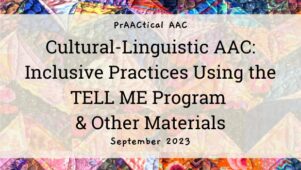
We are excited to continue our series on multilingual AAC support, guest-authored by BilingüeAAC. In today’s post, one member of the team, Melissa Tapia, addresses ways to use specific instructional materials with bilingual individuals. BilingüeAAC is a group of SLPs with a shared belief in providing evidence-based intervention strategies and resources to bilingual Spanish AAC clients, families, caregivers, and professionals. Inclusive Practices Using Tell Me Program & Other Materials How can we effectively conduct inclusive practices in our work settings? What are some approaches or materials that we can use to integrate the culture of the home and community? Why are inclusive practices essential for the success of our students/clients? These are fundamental reflective questions I have found to guide me in collaborative therapy and lead to better participation with and from my clients and their caregivers. We are Bilingue AAC, and we are here to provide helpful tools to... [Read More...]









